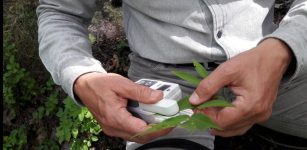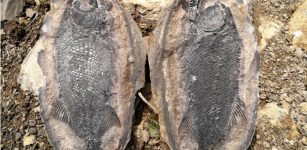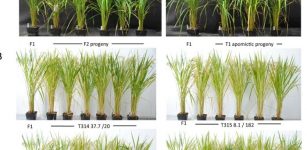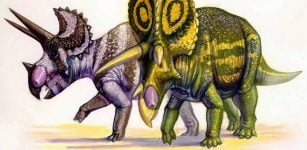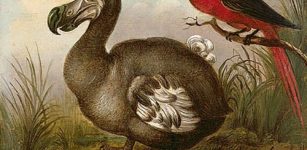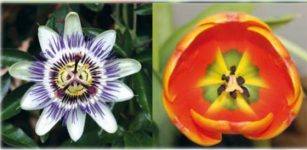‘One Of The Botanical Wonders Of The World’: Giant Waterlily Grown At Kew Gardens Named New To Science
Eddie Gonzales Jr. – MessageToEagle.com – A new paper, published today in the journal Frontiers in Plant Science, outlines a new botanical discovery in the genus Victoria, the famous giant waterlily genus named after Britain’s Queen Victoria in 1852.
Until now, there have only been two known species of giant waterlily, the new species makes it three. Specimens of the new species, Victoria boliviana, have been sitting in Kew’s Herbarium for 177 years and in the National Herbarium of Bolivia for 34 years. During this time, it was commonly believed to be Victoria amazonica.
Botanical horticulturist Carlos Magdalena (left) and botanical artist and illustrator Lucy Smith (right) holding up a leaf of the newly-named Victoria boliviana in the Princess of Wales Conservatory at the Royal Botanic Gardens, Kew in London, UK. Credit: RBG KEW
However, after years of investigation, a team headed by Kew’s scientific and botanical research horticulturist Carlos Magdalena, freelance Kew botanical artist Lucy Smith, and biodiversity genomics researcher Natalia Przelomska, alongside partners from the National Herbarium of Bolivia, Santa Cruz de La Sierra Botanic Garden and La Rinconada Gardens, have finally been able to confirm it as a new scientific species using novel data and their unique mix of expertise.
The paper’s authors decided to name the species in honor of Bolivian partners and the South American home of the waterlily where it grows in the aquatic ecosystems of Llanos de Moxos. With flowers that turn from white to pink and bearing spiny petioles, V. boliviana is now the largest waterlily in the world, with leaves growing as wide as 3 meters in the wild. The current record for the largest species is held by La Rinconada Gardens in Bolivia where leaves reached 3.2 meters.
A botanical challenge
Species in the genus Victoria have been poorly characterized for decades. This knowledge gap stems from an absence of ‘type specimens’ (specimens of the original plant used to formally describe the species) in global plant collections—this is mainly due to the fact that giant waterlilies are difficult to collect in the wild. In 1832, V. amazonica was the first species to be named in the genus but data have been lacking to enable comparisons against any new species found since—a factor which led to the original misidentification of this new waterlily.
With the goal of improving knowledge of Victoria, the paper’s authors compiled all existing information from historical records, horticulture and geography, and assembled a dataset of the species’ characteristics using citizen science (iNaturalist app and social media posts tagging Victoria and giant waterlilies), and specimens from herbaria and living collections around the world.
Botanical artist and illustrator Lucy Smith was tasked with creating contemporary scientific illustrations of the two known Victoria species, for the first time since since Kew artist Walter Hood Fitch illustrated it in 1847 and 1851. Credit: LUCY T SMITH
Scientists Natalia Przelomska and Oscar A. Pérez-Escobar from Kew also analyzed the DNA of V. boliviana and found it was genetically very different from the other two species. The data collected confirmed what the authors had suspected—that there are in fact three species in this iconic genus: V. amazonica, V. cruziana and V. boliviana. Their results suggest that the new species is most closely related to V. cruziana, and that they diverged around a million years ago. Natalia says: “in the face of a fast rate of biodiversity loss, describing new species is a task of fundamental importance; we hope that our multidisciplinary framework might inspire other researchers who are seeking approaches to rapidly and robustly identify new species.”
Dr. Alex Monro, Research Leader in the Americas team at RBG Kew and senior author of the paper says, “Having this new data for Victoria and identifying a new species in the genus is an incredible achievement in botany—properly identifying and documenting plant diversity is crucial to protecting it and sustainably benefiting from it. This paper has been an extra special one to work on because it brings together expertise from across so many different fields—horticulture, science, and botanical art, and has involved working in close collaboration with our Bolivian partners. Victoria has a special place in the history of Kew, having been one of the reasons that Kew was saved from closure in the 1830s. To have played a role in improving knowledge about these magnificent and iconic plants has added resonance for the Kew partners.”
A waterlily experts’ hunch
After suspecting for years there was a third species in the Victoria genus, Magdalena, a world expert on waterlilies, began making enquiries to gardens in Bolivia. In 2016, Bolivian institutions Santa Cruz de La Sierra Botanic Garden and La Rinconada Gardens donated a collection of giant waterlily seeds from the suspected third species. As Carlos germinated and grew the seeds back at Kew, watching the waterlily grow side-by-side with the other two Victoria species, he knew immediately something was different. In 2019 he visited Bolivia to check out the waterlily for himself in the wild and was amazed.
He says, “Ever since I first saw a picture of this plant online in 2006, I was convinced it was a new species. Horticulturists know their plants closely; we are often able to recognize them at a glimpse. It was clear to me that this plant did not quite fit the description of either of the known Victoria species and therefore it had to be a third. For almost two decades, I have been scrutinizing every single picture of wild Victoria waterlilies over the internet, a luxury that a botanist from the 18th, 19th and most of the 20th century didn’t have. I’m also spoiled by the fact that here at Kew we can grow all the species together side by side and in the same conditions, which excludes changes in shape and color due to environmental conditions. In the wild, Victoria grows over a vast extension, and this comparison is not possible. I have learnt so much in the process of officially naming this new species and it’s been the biggest achievement of my 20-year career at Kew.”
A botanical artists’ nocturnal observation
Whilst Magdalena was growing and researching the new species at Kew, Lucy Smith, one of Kew’s team of highly skilled freelance botanical artists, was already working on a project to make contemporary scientific illustrations of the two known Victoria species, a task that had not been attempted since Kew artist Walter Hood Fitch illustrated it in 1847 and 1851.
As the flowers of giant waterlilies only open at night, Lucy made many nocturnal vigils to the glasshouses to capture the flowers for drawing and painting. When the first flowers of V. boliviana opened on a stormy evening in July 2018, she shared Carlos’s suspicions that it was unique and quickly set about to describe those differences using illustrations. What particularly caught her eye was the similarity between this new plant, and the one which Fitch drew from a specimen collected in Bolivia in 1845 and in fact, it proved to be the same one, unknown as a new species to Fitch at the time.
Lucy says: “For me, the confirmation and description of this new species pulls together threads connecting my work as a modern-day botanical artist to the work of Kew’s Walter Hood Fitch. My work as a botanical artist for Kew has trained me to identify and depict the differences between plant species. I was excited to take this one step further by not only illustrating the existing and new species, but also being a lead author of the paper. I hope that the illustrations will help others identify all three species of the giant Victoria waterlilies for years to come.”
A Bolivian specimen collected in 1988—unknown at the time to be a new species
Dr. Stephan G Beck, Professor Emeritus, researcher of the National Herbarium of Bolivia partnered with the Kew team to formally describe this new species. Stephan collected the type specimen for the waterlily unknowingly in 1988 thinking it was Victoria cruziana—his specimen trumps the 1845 Kew specimen as it holds more data and provides better knowledge about the species.
The paper’s authors named the giant waterlily species in honour of their Bolivian partners and the South American home, where it grows in the aquatic ecosystems of Llanos de Moxos. Credit: CARLOS MAGDALENA
He says: “When the National Herbarium of Bolivia was born in 1984, there were very few scientific collections for Bolivia and many places to study, but I focused my interest on an area in the Llanos de Moxos. For several years I had the opportunity to collect aquatic plants in flooded areas of the Yacuma River, and obviously longed to see the ‘Reina Victoria’ which the locals told me about. However, it took me years to find this tremendous plant. Finally, in March 1988 after sailing over two hours up the Yacuma River looking for tributaries with several huge leaves and some flowers, I collected and preserved them in the National Herbarium of Bolivia, which turned out to be a specimen of Victoria boliviana, now the type specimen. It was a great find and one I will always remember.”
DNA Secrets
Another striking result achieved through the analysis of the DNA of the new species and the two other Victoria species was the time of origin of this new species and its kinship. The results suggest that the new species, V. boliviana, is most closely related to V. cruziana and that these two sister species diverged around a million years ago.
Natalia Przelomska, who led the genomic part of the study, says: “Analyzing the DNA of the giant waterlilies presented some interesting challenges—most of the material I worked with in the laboratory consisted of slightly cooked fragments of waterlily leaves (being fleshy, they are difficult to dry and make herbarium specimens from), also covered in prickles. Once we had generated DNA sequences, our next challenge was the analysis of this data, given that the genome of Victoria has been poorly studied so far and is larger than that of any other waterlily (as we know from our co-authors’ previous work on V. amazonica and V. cruziana). As a researcher who has a passion for multidisciplinary work it was very rewarding to play a role in tying together these lines of evidence to reach a robust, collaborative conclusion. In the face of a fast rate of biodiversity loss, describing new species is a task of fundamental importance and we hope that our work can inspire others to try new approaches to rapidly identify new species.”
The Victoria boliviana is now the largest waterlily in the world, with leaves growing up to 3m across in the wild. The biggest-known specimen (not pictured) is presently housed at the La Rinconada Gardens in Bolivia, with leaves up to 3.2m across. Credit: RBG KEW
Dr. Oscar A. Pérez-Escobar, Research Leader at RBG Kew says: “Understanding the pace at which plant species originate and go extinct is crucial, to determine the time of formation and maintenance of the different world floras. To discover through DNA that a plant group that has so few species and is thought to have originated in the mid Paleogene (~40 million years ago) is still speciating as recent as 1 million years ago is remarkable! There are many aspects about the life history of Victoria which we haven’t answered, and our research provides the foundations for future studies focused on elucidating what is driving speciation in this remarkable plant genus.”
The study was published in the journal Frontiers in Plant Science
Written by Eddie Gonzales Jr. – MessageToEagle.com Staff





